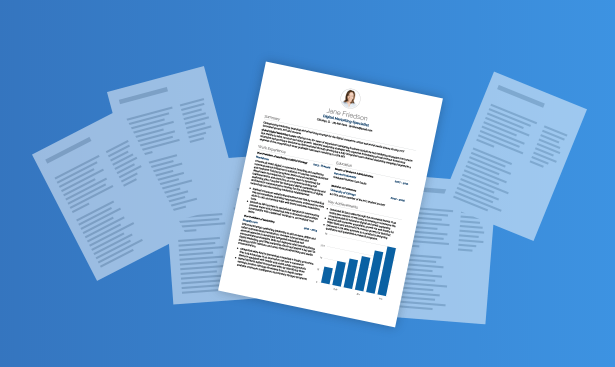How to Create a Living Resume

The following is a guest post by James Clift. His bio follows.
When you’re a freelancer or on the job hunt, your resume is possibly your best marketing tool for picking up new employer and/or clients. While every new engagement is a chance to broaden your experience, that is not always conveyed when searching for the next new opportunity. Like many of us, there’s a strong temptation to create a resume once, click “save,” and then use it over and over again without any specificity. But that’s a critical mistake. Your experience is by no means static and your resume shouldn’t be either.
To stay competitive in the marketplace and to truly stand-out, it’s important to create a living resume,” which is a constantly evolving CV that reflects your latest skills and experience. Without one, your business could slow down significantly amid today’s rapidly growing freelance market as one study predicts by 2020 more than 40 percent of the American workforce, or 60 million people, will be independent workers.
Gaining an edge over other freelancers in your field starts with a well-crafted and highly personalized resume which is easier than you may think. Start by following these five tips, and you will be well on your way to creating a stellar living resume:
Take inventory of your accomplishments
Has it been a while since you’ve updated your resume? If so, it’s time to dust it off and take stock of your achievements to date. After all, your resume should highlight your most noteworthy accomplishments that can quantify your success and your value. If you’re a freelance writer, for example, your resume might state that you wrote 10 press releases in a one-week period, working under daily deadlines for a past client. Better yet, provide a link to writing samples that show off your work so potential clients can evaluate your writing skills.
Sales jobs, meanwhile, lend particularly well to metrics. For instance, if you exceeded annual sales goals by 70 percent and grew revenue by 20 percent, highlight it on your resume.
Stay on top of industry trends
To successfully pitch your services, you’ll need to prove you possess knowledge of current trends in your field. One way to do that is to make sure your resume reflects your understanding of changes in your industry.
To stay apprised of the latest industry trends, you’ll want to subscribe to trade journals, attend conferences and local networking events, join Webinars, and participate in online forums. When you discover a new skillset that is worth adding to your repertoire, consider taking a class or online course—either through Udemy.com, Coursera.org, or Skillshare.com—and then add the certification to your CV. Including industry-specific credentials on your resume can also help your resume pass through application tracking systems (ATS), which is the software used by many employers to scan resumes for keywords.

Diversify your portfolio
Samples of your work are powerful, since they enable you to demonstrate your skills to prospective clients or employers. Today, online resume solutions enable individuals to create a custom portfolio for each type of job application. This level of customization is essential for freelancers in particular, as each gig has its own set of unique requirements. For example, a writer might have one portfolio showcasing their technical writing skills and a second portfolio for their editorial pieces. A graphic designer, however, might have one portfolio for work that they’ve created for small businesses and a second portfolio for corporate clients.
Always tailor your resume to the proposal
Think of your resume as a template that you tweak for each specific request for proposal (RFP). Prospective employers have become far more sophisticated in reviewing/selecting whom they want to bring on and undoubtedly will be able to sniff out a generic resume, which is an immediate turnoff. In fact, a 2015 survey by national staffing firm Addison Group found that 90 percent of hiring managers said they’ve noticed when a resume isn’t tailored to the role in question.
When tailoring your resume, draw from the language used in the job posting. For example, what one company might call “customer service” another might call “client relations”—it’s a small distinction, but trust me it’s important.
Be mindful of formatting
Maintaining your resume as a plain text document such as Microsoft Word, isn’t going to cut it in today’s freelance market. This is because clients and employers require resumes to be submitted in different formats and yes, some even still ask for them to be shipped by snail mail! With this in mind, be sure to maintain a PDF copy of your resume, as well as a one-page 8.5×11 resume that you can print and bring to consultations.

Leverage all avenues but make sure they are all up to date
So, while you have your resume up to date, you’ll also benefit by keeping your LinkedIn profile relevant. This is a crucial step, since 87 percent of recruiters use the network to find and vet job candidates, according to reports. Also, they expect to see similar experience on the site and in your CV.
Combined, your resume, LinkedIn profile, and portfolio should always be packed with current information detailing your diverse set of skills, credentials, and experience. After-all, taking the time to ensure all existing document are relevant, current and in-synch are key to ensuring your livelihood can outlive the competition.
About the Author:
James Clift is CEO of VisualCV, the largest online resume and portfolio creation platform with over 1 million members in dozens of countries worldwide. For more information visit https://www.visualcv.com or follow the company on Twitter @visualcv.

